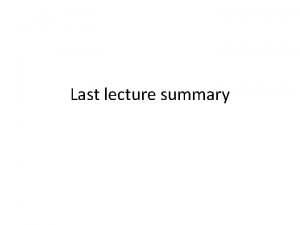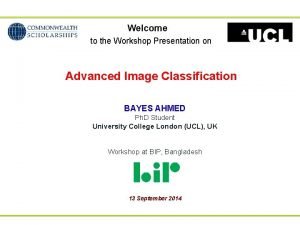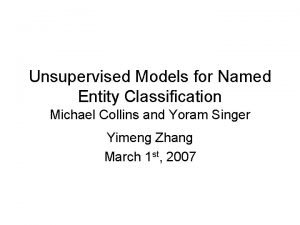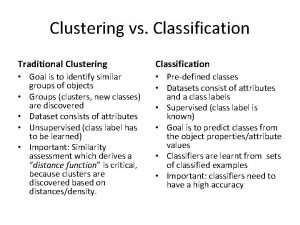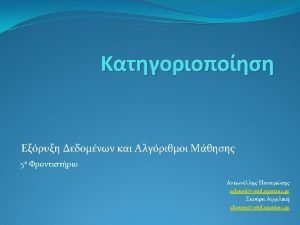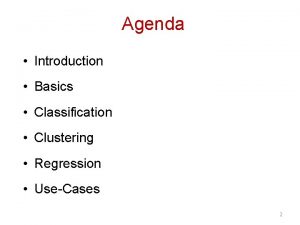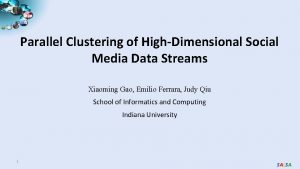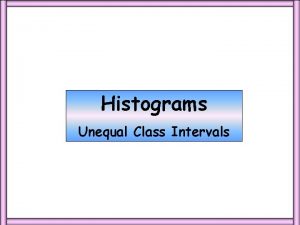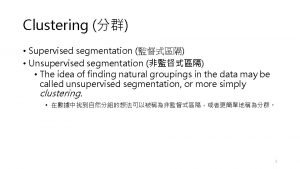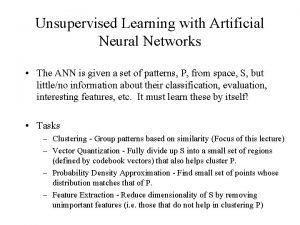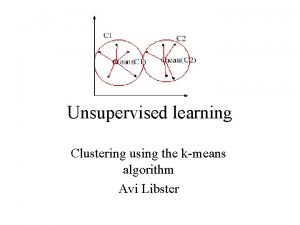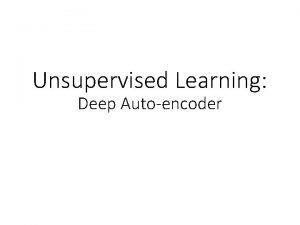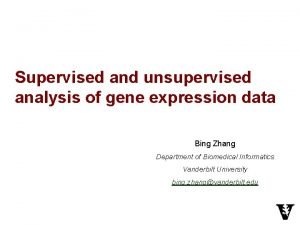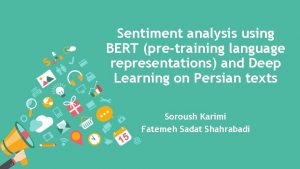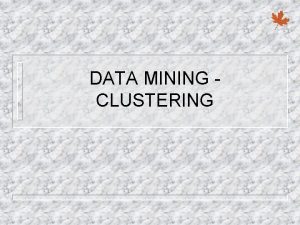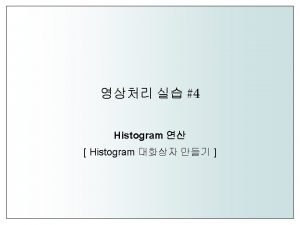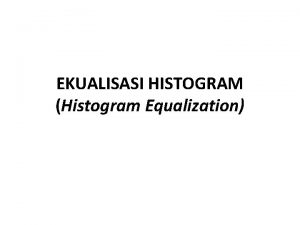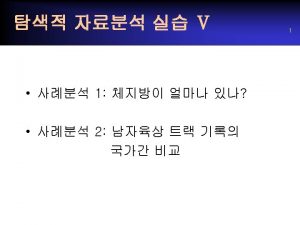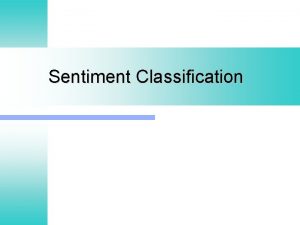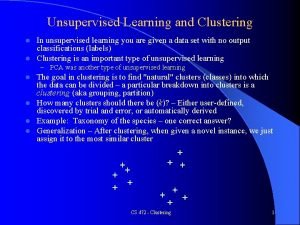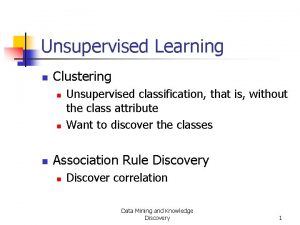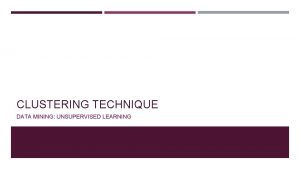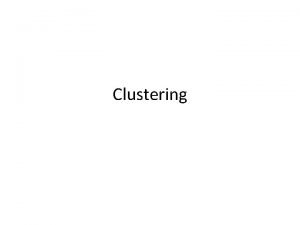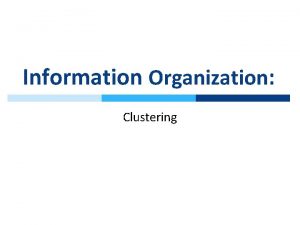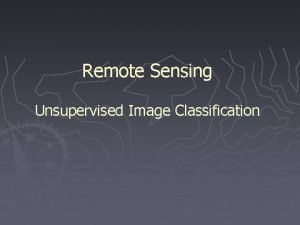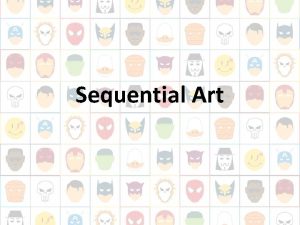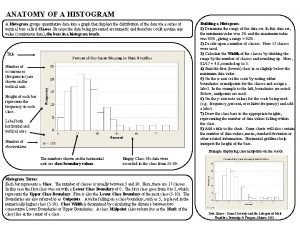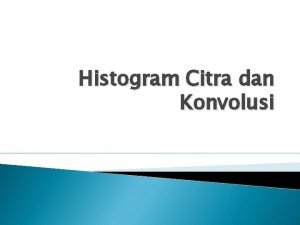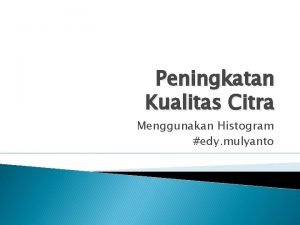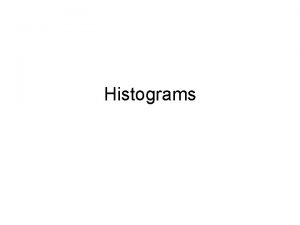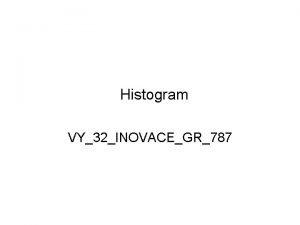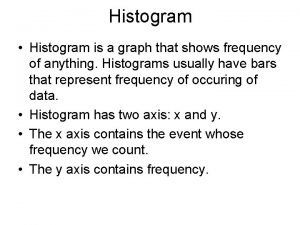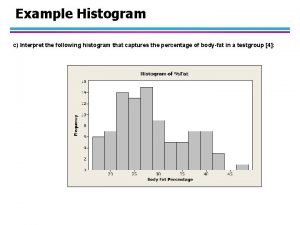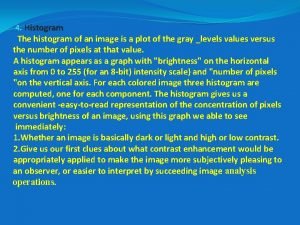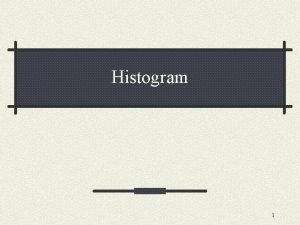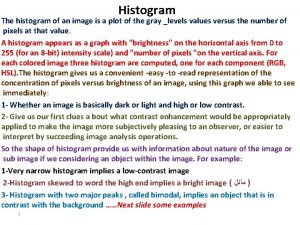Class 10 Unsupervised Classification Histogram Classification Sequential Clustering




























- Slides: 28

Class 10 Unsupervised Classification Histogram Classification Sequential Clustering ISODATA Clustering Grouping Based on Spectral Similarity

Definition Unsupervised classification is a process of grouping pixels that have similar spectral values and labeling each group with a class Supervised classification is to classify an image using known spectral information for each cover type Verbyla 6

1. Histogram-based unsupervised classification spruce rocks water willow

Classification thresholds based on histogram peaks Spectral Class 1 Range of Digital Values Less than 60 2 61 through 125 3 126 through 162 4 Greater than 162

One-band image, example 230 201 77 73 68 230 201 143 147 153 102 89 139 23 15 98 91 137 26 18 94 90 125 222 13

One-band image, classified 4 4 2 2 2 4 4 3 3 3 2 2 3 1 1 2 2 2 1 1


2. Sequential Clustering (K-mean clustering) By assigning pixels in some sequence to different classes according to spectral distance of each pixel from the mean of each class

Spectral distance i. Two band spectral distance Band 2 (x 2, y 2) (x 1, y 1) Band 1 Spectral distance = (x 2 -x 1)2+(y 2 -y 1)2

Spectral distance ii. Three band spectral distance Spectral distance = (x 2 -x 1)2+(y 2 -y 1)2 +(z 2 -z 1)2 iii. In general: n Spectral distance = [ (xi 1 -xi 2)2]0. 5 i=1

Procedures for sequential clustering Pass#1 (for a subset of the image using a skip factor) Step 1: define maximum allowable number of spectral classes Cmax define maximum allowable spectral distance between classes Dmax Step 2: start at pixel (1, 1) and proceed sequentially from left to right. For a pixel, find D for all existing classes, i. e. , D 1, D 2, D 3, …Dn. If all Di<Dmax, assign the pixel to the class which has the smallest D. If Di>Dmax, and C<Cmax create a new class Pass#2 (for the whole image) Start at pixel (1, 1), process pixel by pixel. A pixel will be assigned to a class which has the minimum spectral distance from the pixel.

Example (two band image to classify) 50 43 78 65 88 123 125 99 244 233 59 49 128 98 209 154 117 88 67 33 78 193 198 231 205 99 233 198 205 132 22 141 245 241 109 75 239 202 100 38 58 233 245 249 14 189 217 156 114 48

Sequential Clustering Criteria Example 1. Maximum allowable number of spectral classes =10 2. Maximum allowable distance to spectral class mean=40




Example (two band image classified by SC) 1 1 2 3 4 1 3 5 3 1 6 7 8 4 5 9 4 3 4 1 10 4 9 5 3 Next task: to label the classes

3. ISODATA clustering (Interactive Self-Organizing Data Analysis) It is an unsupervised classification method opposite to the sequential clustering. It starts with all pixels as a class and gradually splits it to a desired number of classes Verbyla Chapter 6

Criteria of ISODATA i. ii. • • Starting criterion: initial number of spectral classes Processing criteria: Splitting criterion: maximum variation of spectral class Merging criteria: maximum distance between classes maximum number of members in a class Iii. Stopping criteria: maximum iterations desired percent unchanged classes

Procedures of ISODATA Pass #1 i. ii. Split any class that is too variable, i. e. , the standard deviation exceeds the maximum allowed. Merge any spectral classes that are too close, i. e. , distance between class means is less than the minimum specified Pass #2 Classify pixel by pixel according to the minimum distance from the class centers found in pass #1

Example Criteria: Initial number of classes =1 Maximum standard deviation = 40 Maximum distance between classes =5 Maximum classes =5 Minimum number of members (pixels) in a class =2 Maximum number of iteration =3 Desired percent unchanged class members=90%





Example (two band image classified by ISODATA) 1 1 2 1 5 1 1 4 1 1 3 5 4 2 5 1 3 5 3 4 1 Next task: to label the classes

4. Grouping based on Spectral Similarity This provides the basis for further reducing the number of classes obtained using other unsupervised classification methods. Mean digital values Spectral Classes Band 1 Band 2 1 2 3 4 5 10 20 30 30 50 5 20 55 40 90 Verbyla 6

4. Grouping based on Spectral Similarity This provides the basis for further reducing the number of classes obtained using other unsupervised classification methods. Verbyla 6
 Unsupervised hierarchical clustering
Unsupervised hierarchical clustering Flat cluster
Flat cluster Bond energy algorithm
Bond energy algorithm Rumus distance
Rumus distance Iso cluster unsupervised classification
Iso cluster unsupervised classification Unsupervised models for named entity classification
Unsupervised models for named entity classification Supervised data mining
Supervised data mining Clustering vs classification
Clustering vs classification Clustering vs classification
Clustering vs classification Clustering vs classification
Clustering vs classification Classification and clustering in data mining
Classification and clustering in data mining Classification regression clustering
Classification regression clustering Classification and clustering
Classification and clustering Unequal histogram
Unequal histogram Unsupervised learning in data mining
Unsupervised learning in data mining Gradient reversal layer
Gradient reversal layer Lda supervised or unsupervised
Lda supervised or unsupervised Transductive learning for unsupervised text style transfer
Transductive learning for unsupervised text style transfer Autoencoders, unsupervised learning, and deep architectures
Autoencoders, unsupervised learning, and deep architectures Unsupervised segmentation
Unsupervised segmentation Ann unsupervised learning
Ann unsupervised learning Is pca unsupervised learning
Is pca unsupervised learning Unsupervised learning
Unsupervised learning Andrew ng introduction to machine learning
Andrew ng introduction to machine learning Supervised vs unsupervised data mining
Supervised vs unsupervised data mining Deep reinforcement learning example
Deep reinforcement learning example Contractive autoencoder
Contractive autoencoder Supervised and unsupervised learning
Supervised and unsupervised learning ü
ü
